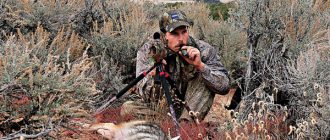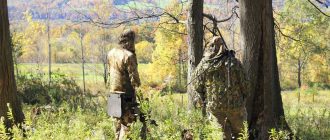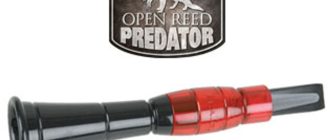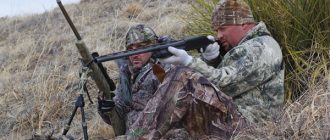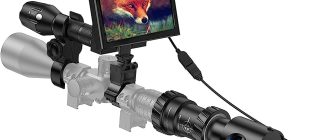
Body Position or Stance
One of the most important parts of being a good or effective shooter is consistency. This means doing the same thing every time you take a shot. This starts with your shooting position. While predator hunting you might shoot from multiple positions, such as kneeling, standing, sitting, or lying prone; but the most common shooting position is probably the sitting position. No matter what position you choose a solid shooting position is essential to good shooting. The more solid the position the easier it is to hold your predator rifle still and control the trigger. You should have as much of your body directly behind the gun as possible and have as many things pointing at the target as possible. This includes your feet, hips, shoulders and hands. But ultimately control of the rifle needs come from the upper body. Your lower body needs to be able to conform to the ground, while your upper body drives the gun. There are three elements to any good shooting position.
Bone Support
A good shooting position utilizes bone support, not muscle support. A strong foundation is a necessity when shooting as is the foundation of a building essential to its strength.
Muscular Relaxation
As a predator caller you must learn to relax in various shooting positions and situations. Any undue strain or tension causes you to shake, which is transmitted to your predator rifle. While shooting, see if you can wiggle your toes. If you’re relaxed enough to wiggle your toes…you’re relaxed.
Natural Point of Aim
Natural point of aim is when your body, the rifle and the target are perfectly aligned. A perfect natural point of aim in any position is the key to accuracy. If your natural point of aim is perfect, your rifle will be right on target when it hits your shoulder and you won’t have to muscle the gun left or right to get it on target. To find your natural point of aim, establish your target, take a deep breath and exhale. Next, concentrate on making your body completely relaxed. This will cause the gun to fall to your natural point of aim. Breathe normally, if the crosshairs move straight up and down the center of the target you have established your natural point of aim. If you practice it enough your body will learn what a good shooting position feels like and you’ll naturally end up in a more adventitious position to deal with approaching predators.
Grip
A solid grip is vital to placing accurate rounds on predators. As sure as having a loose scope mounted on your rifle; a loose grip will cause rounds to fly aimlessly off their mark. You need to check your grip to make sure you’ve got the best connection between yourself and your predator rifle.
The gun is controlled with your forearm or support hand, leaving your strong hand to concentrate on pulling the trigger. To give you the most support, grip your gun as far out on the gun as possible. There are a number of different ways to grip the gun, but it’s important to get your hand as high as possible on the gun because the recoil of the gun is going to kick the gun up. If you’re trying to hold the gun from underneath it’s going to bounce out of your hand every time. For the same reason it’s important that you take that hinge-point (elbow) out of the equation. By simply rotating the arm out to the side, you eliminate the hinge and are better able to drive the gun. Point anything you can at the target. In this case, depending on your grip, you can either point your thumb or your index finger.
Sight Alignment
Sight alignment is the relationship between the crosshairs (reticle) and the target. In other words, put the reticle where you want to hit the animal. Sight alignment with a rifle scope is done when you sight in your rifle.
Sight Picture
A proper sight picture is when you have a full field-of-view when you look through your scope, with no black areas around the edges of your scope. Ideally, you’ll have a perfect sight picture every time your rifle hits your shoulder without having to move your head forward, backward, up or down. To get there, you may have to lengthen or shorten your stock, or build up the cheek-piece so you get a full sight picture with your head erect.
You’ll miss more and shoot bigger groups if you can’t get a good sight picture consistently. Accuracy is all about consistency. If your head isn’t on the same part of the stock and your sight picture isn’t exactly the same every time your rifle hits your shoulder, you will never have the consistency to be a good shot.
Breathing
If consistency is the key to accuracy, your lungs must have the same amount of air when you break each shot. The natural up and down motion of the chest while breathing, causes the rifle to move up and down. You must therefore accomplish your sight picture while breathing and finish aiming while holding your breath. You do this by inhaling, exhaling, and stopping at the natural respiratory pause before beginning to inhale again. You should fire during this pause when your breathing muscles are relaxed. Timing is critical because your sight picture will blur if you hold your breath too long. Shoot at a natural respiratory pause consistently and your groups will shrink. You’ll also enjoy more success taking predators in the field, especially at longer distances.
Trigger Control
Effective trigger control starts with establishing a good grip. Wherever your finger hits the trigger is the best place for you to put your finger on the trigger. With the gun comfortably in your hand you’re going to have much better trigger control. Keep the 2nd joint of your trigger finger pointed straight at your target as you press the trigger. By doing so it’s nearly impossible to push or pull the shot with your trigger finger. To fire an effective shot, the pressure on the trigger needs to be smooth and even. This doesn’t necessarily mean slow. You can pull the trigger as fast as you want as long as it’s smooth. When pulling the trigger you need to have visual patience, which means that you don’t rush your shot if it’s not there. You need to wait as long as it takes to see what you need to see before you shoot. The only other option is missing the shot.
You can improve your trigger control by making sure your rifle has a good, crisp trigger pull. You don’t need an ultra-light bench rest trigger, but a clean two to three-pound trigger pull will make a big difference in your shooting.
Follow Through
You could do everything else right and still make a bad shot if you don’t keep your head locked down on the stock and recover right back on target. Looking up is one of the most common culprits among predator hunters. Fortunately, it’s an easy one to fix, just focus on watching the predator fall in your rifle scope. Follow-through simply means that you continue to apply all the fundamentals of marksmanship after your predator rifle fires.
Now that we have a basic list of rifle shooting tips, what’s next? As the saying goes, “Practice makes perfect”. One of the best ways to practice is to get a snap cap for your rifle, cut out a picture of your favorite predator, and commence dry-firing as you focus on the fundamentals of marksmanship.

